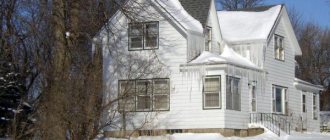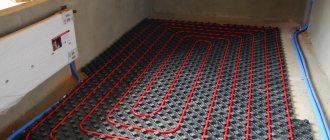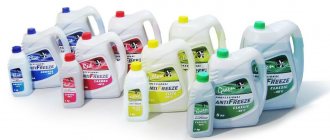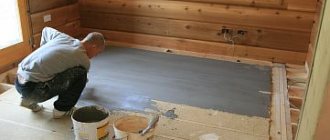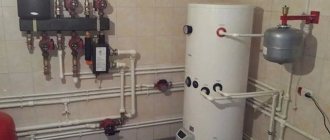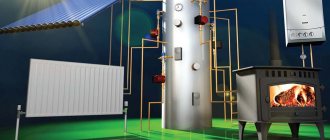If a property owner plans to live in a dacha in cold weather, he needs to think about the heating system of the property. Manufacturers of heating equipment have provided a large selection of devices and components to create favorable conditions in the home. Determining the heating method depends on the size of the room and the degree of wall insulation.
An affordable option for heating a two-story house with an electric boiler
Important points to consider when choosing a heating project
The final characteristics of the property depend on the foundation, wall insulation and room heating. When choosing economical heating, you need to take into account the parameters of materials. The insulation retains heated air for a long time.
It is necessary to analyze the fire hazard of the house, since heating systems can lead to fire. To avoid problems with heating rooms, you need to find out whether it is possible to buy coal, firewood, and diesel fuel near your home.
If fuel has to be imported from another region, this will significantly increase the final costs of maintaining a comfortable temperature in the house.
Savings when designing a home
Economical heating systems can operate as efficiently as possible only when the optimal temperature regime is organized. When planning a house, you need to take into account that the rooms that border the outer wall cool much more in winter, unlike those located in the center.
Therefore, if you provide for the location of rooms that need a higher temperature, and rooms where the temperature can be lowered, then the heating system will work much more efficiently and not consume a large amount of energy:
- Rooms where a temperature of at least 22-27 degrees is required: children's room, bedroom, living room, bathroom.
- Rooms where a lower thermal regime is possible: office, kitchen, pantry, dressing room.
Thermal insulation of the building
When organizing economical heating of a building, it is necessary to remember about high-quality thermal insulation of the house. Even the most efficient heating system will run idle if the heat it gives off starts to leak out into the street. Even when there are no drafts on walls without thermal insulation, not only will the air begin to cool, but condensation will also accumulate. Cold floors can reduce the operation of any heating circuit to zero. Poor quality doors and windows will also contribute to this.
Of course, the lower the temperature in the area where the house is built, the more you will need to spend on its thermal insulation. But a well-insulated building will require half as much heating energy as a conventional house. Thus, savings on fuel during any heating option will be quite significant.
This factor must be taken into account at the planning stage of the house, selecting materials with high thermal insulation rates for its construction. But an already constructed building can also be successfully insulated. Today there are a large number of different insulation materials on the market that have low thermal conductivity and are suitable for DIY work.
The following insulation materials can be used:
- glass wool;
- Styrofoam;
- polyurethane foam;
- expanded polystyrene;
- mineral or basalt wool;
- expanded polystyrene.
Each of the materials has certain advantages and disadvantages, and the possibility of using any will depend on the installation location and the material of the walls. Experts know all these nuances very well and will be able to recommend which insulation to choose in each specific case.
Additional features
Thanks to modern devices, your home can be made even more economical using the following devices:
- Geothermal heating systems, solar panels and condensing boilers. These devices help save money because they can supply cheaper or even free energy. But these systems require quite significant initial costs, which can take a long time to pay off.
- Programmer. Using the device, you can automatically adjust economical heating, setting the required thermal regime by day or hour. For example, when residents are away from home, you can set the temperature to 15-16 degrees, and by the time they arrive, increase it to 23-25 degrees. Lowering the temperature by one degree approximately saves up to 7% of energy resources.
Choosing the most economical heating option for your home is quite difficult.
Heating can actually be inexpensive, but you just need to take the choice of a particular technology with the utmost responsibility, find out all the main advantages and disadvantages, spend a lot of time studying all the information and monitoring construction market equipment. In contact with
Main types of heating units
Autonomous heating can be automated. The following coolants are used:
- Steam.
- Electricity.
- Hot water.
- Air.
High-quality installations operate on solid fuel, gas cylinders, and diesel fuel.
All types of heating have disadvantages. If the user analyzes all the options in terms of the cost of the coolant, then the most expensive fuel is diesel fuel, the most affordable is gas.
Heating the cottage with gas
To properly install autonomous heating in your dacha, you need to study the recommendations of specialists. If the property is connected to a central gas main, the system must be installed by a specialist. The boilers have a high level of heat transfer; the equipment can be equipped with batteries that accumulate all unspent heat.
The owner of a property needs to think in the summer about how to economically heat his dacha. Heating equipment will cost more than a conventional stove. You need to draw up a detailed plan and invite specialists. The main danger is that improper operation of a gas installation can lead to an explosion.
The video provides interesting information on how to install heating in a house without gas:
How to insulate a roof
In a country house with a cold attic, sawdust would be the ideal insulation material. It's cheap, reliable, and simple. I poured a layer of 30 centimeters on the ceiling and forgot.
car enthusiast Member of FORUMHOUSE
Sawdust provides good insulation. As a bulk material, they do not have problems with heat leakage through the joints of slabs and in places adjacent to beams, racks and other irregularities. Well, very budget-friendly.
If, due to the hassle of lifting into the attic, loose insulation is not considered in principle, you can lay polystyrene foam. It’s quick and cheap, but mice love to live in polystyrene foam, and it’s a “loud” material: when mice begin their active mouse life in it, it seems like elephants are running around the attic. Therefore, many people choose mineral wool to insulate their country house.
It is always better to insulate from the outside, but you can also insulate from the inside: with slab insulation or universal foil insulation. The ceilings of houses in which people live permanently are not insulated that way, but dachas are completely insulated.
How to insulate a dacha ceiling with slab insulation:
- Clean it from dirt and dust;
- Make a sheathing: attach bars or profiles to the ceiling at a distance equal to the width of the insulation. The thickness of the bars should be the same as that of the insulation boards, and the profile is screwed to special hangers;
- If the finished ceiling is plasterboard, the lathing is made from a profile. If it’s lining or OSB, you can take bars treated with an antiseptic.
- Attach waterproofing to the finished sheathing by cutting out strips from the material equal to the distance between the sheathing beams + 5 cm on each side. The waterproofing is attached to the wooden sheathing with counter-battens, and to the profile with self-tapping screws.
- Place mineral wool or other board insulation on the waterproofing. For such insulation of a ceiling in contact with a cold attic, take insulation 10–16 cm thick. It is attached to the ceiling with a construction stapler or glue. If the insulation layer is thick, it is also attached to the sheathing.
- A vapor barrier is attached to the mineral wool with a stapler, and transverse counter-battens or a profile are mounted on top.
- The last stage is the installation of the finished ceiling.
To insulate the ceiling with foil thermal insulation, you need to choose a material of the maximum possible thickness (but they are all thin) and install it with the foil down. Here the reflective surface of the insulation will work, and you can quickly feel the effect; the house will become noticeably warmer. This insulation works most effectively if there is an air gap on both sides of it, so you need to make a lath on the ceiling, and install a counter-lattice on the material. The material is attached to the sheathing joint-to-joint, and the assembly seams are taped with aluminum tape.
Such insulation cannot be installed with an overlap!
IrinkaS Member of FORUMHOUSE My pie is like this from top to bottom: Ventilation gap, penofol, ventilation gap, sheathing.
Portable and portable systems
Suitable for heating small cottages in winter. Classic country houses are often designed for seasonal living, and the installation of complex equipment requires large investments.
In such a situation, it is better to use portable models of electric heaters. Infrared panels and oil batteries are in greatest demand. They have diametrically opposed principles of action. An oil heater heats the air, and an infrared panel blasts surfaces with infrared rays. The efficiency indicator reaches 93%.
Devices in this category have the advantage of being easy to move from room to room, heating only living spaces. This option is appropriate when the dacha is used seasonally.
Installation of IR panels on the ceiling
Installation features
As we have already said, when connecting electric heating in a wooden house, you must adhere to several important requirements, namely:
- When heated, wood can dry out and crack, so avoid direct contact with the heat flow on the walls and ceiling. It is best to point the devices towards the floor and towards the center of the room.
- If you decide to use radiators, their installation in a wooden house also has its own peculiarities. Over time, wood shrinks. If you do not provide special compensators on the risers in the design of the house, during shrinkage the heating main may be disrupted and fail.
- The power cable from which the electric boiler (or boiler) will be powered must be able to withstand current loads with a reserve. Otherwise, ignition may occur from spontaneous combustion of the electrical wiring. To prevent this from happening, calculate the cable cross-section based on power.
- When using UV intensifiers, place them in such a way as to prevent direct (or very close) contact of the heating element with other objects.
The most economical heating method
Using a stove in a dacha in winter without electricity or gas is in great demand. But a high-quality chimney is necessary. Without this element, the stove heating unit will not be able to operate.
The disadvantage of the stove is that the user must ensure that the wood or coal does not burn out. Periodically it is necessary to clean the structure from fuel decay products.
To achieve maximum efficiency when using a stove to heat a dacha in winter without electricity, it is better to prepare oak, hornbeam or beech firewood. Pine and spruce do not provide comfortable heating of the air.
An excellent option for a summer house is a multifunctional potbelly stove. The category of innovative heating inventions includes long-burning boilers, the operating principle of which is based on pyrolysis, when wood burns at a low temperature with the simultaneous release of gases.
A modern approach to using a potbelly stove
Combination boilers
If you are installing heating for your dacha yourself, then a combination boiler is the best choice. Its main advantage is its unpretentiousness in choosing fuel. In addition to coal, briquettes, firewood, electricity is used as an alternative source.
Let’s say there is no way to use gas for heating, and you will only get to the dacha next weekend, the coal supply will definitely not be enough. And what should I do? Use electricity! The best option is to set the temperature below comfortable, but enough to keep the interior warm. This will not only be cheaper, but one addition of fuel will be enough to make the dacha warm again.
This is how a combi boiler works.
The boilers are made of metal three centimeters thick and weigh up to 110 kg, so the foundation must be prepared. Boiler power 3-6 kW. Control, temperature adjustment via remote control. The boiler has a cast iron stove with a burner, there is a modification with two, which is convenient when installing in the kitchen. A combination boiler is a safe solution to the question of how to heat a dacha in winter.
Universal liquid fuel models
More often, specialists have to install high-quality air-type heating for a summer residence, since a comfortable temperature is maintained in all rooms. Boilers running on diesel fuel, fuel oil, waste oil, or kerosene cannot function as an independent unit.
Therefore, the master must provide for a reliable connection of the equipment to the heating system of the wood-burning cottage with batteries, radiators or registers that are located in each room. It is necessary to provide for the availability of free space for installing the boiler and prepare a site for energy storage.
The room must be ventilated and equipped in accordance with fire safety rules.
For a country house, you can choose systems with one or two circuits. The second option is relevant when, in addition to heating, you need to provide water heating for domestic needs. The dual-circuit system can be equipped with a boiler or a flow-through heater. According to their design, liquid fuel boilers are either floor-mounted or wall-mounted.
How to insulate doors
Even if very good doors are installed in a country house, cracks may appear between them and the frame over time, into which heat escapes with a whistle.
They can be foamed or sealed with seals (and below, under the door, a special sealing grille can be placed in this case), or a curtain made of very dense material, plush, wool, etc. can be hung. You can choose a beautiful one and make it into an original backdrop for New Year’s photo shoots.
Reliable solid fuel units
The cottage can be heated without gas. In this case, you will need firewood, coal, briquettes, shavings, pallets, straw, sawdust or peat. Solid fuel boilers are gaining popularity as other sources of thermal energy periodically become more expensive. The units operate stably only in conjunction with a water coolant delivery system in all rooms of the dacha.
Heating a living space with a solid fuel system is beneficial, since the equipment is affordable, reliable, and easy to maintain.
Affordable solid fuel boiler
Alternative options
If the owner of a summer house decides to refuse to heat the property with gas cylinders, then it is worth choosing universal electric infrared emitters. The units heat surrounding objects, which gradually release the accumulated heat into the room. It is best to install heaters on the ceiling to achieve maximum effect.
Convectors have high efficiency, affordable prices, and convenient design. The device can be placed anywhere in the room. The unit can be fixed with brackets to the wall surface or stand on the floor on built-in legs (wheels).
It is possible to heat the house with electric ventilation devices. They are quite cheap and heat the room faster than all analogues. Warm air from the spiral is supplied to the room using a flow of oxygen. Disadvantages: air drying, noisy operation.
Popular infrared emitter
How to insulate windows
The first thing to do is insulate the windows; it’s the easiest thing (and now the dacha is 35% warmer!).
At dachas for seasonal living, expensive windows with a powerful profile and sophisticated double-glazed windows are rarely installed, and the simplest PVC windows provide poor protection from the cold. Over time, the seal in such windows wears out, the clamping mechanisms do not press the sashes so well; and installation, most often done by hand, also sometimes makes itself felt with serious cracks in the seams. There are several simple home tests that can help identify where warm air is leaking into a window.
- Match test. Run a lit match along the closed door - the light will begin to oscillate in places of leakage;
- Paper test. Place a piece of paper between the sashes and run it around the entire perimeter of the window. If the paper moves easily and naturally, the seal is out of order, it’s time to change it.
You need to check the entire window, and under the window sill too. The most problematic places:
- Rubber compressor;
- accessories;
- glazing bead holder.
They need to be given special attention when checking.
Many problems with plastic windows can be eliminated yourself. This is not Newton's binomial; a person with his hands in the right place will cope with this task, even if he has never done anything like this before.
Clamping mechanism. Adjusting the clamping mechanism is very simple: if it is not pressed tightly, the doors are not airtight and there are drafts in the room. All you need to fix this mess is a 4 mm hex wrench or pliers (this depends on the hardware manufacturer). There are eccentrics on the window sash; they look like nuts with a rounded edge.
You need to look at the notch: if it looks out the window, at the seal, then the pressure is strengthened; if she looks out of the window, into the frame, it is weakened.
You also can’t tighten it too much: there is a risk of crushing the seal.
The tightness of the clamp may also depend on the loop. You need to use a hexagon to extend the hinge tongue to the maximum and turn the tool: for left-handed hinges counterclockwise, for right-handed ones - clockwise. If the glazing bead is worn out, remove it (this is easy if you pry it off with a knife or something like that) and replace it.
A window can also let in heat due to a dried out seal; this often happens on country windows, which are looked after much less than windows in permanent residence homes. You can also change the seal yourself.
If there is a problem with the seal behind the glass, then by pulling out the bead and carefully removing the lining and the glass unit, you need to replace it with a new one. The main thing is not to allow any tension, twisting, etc., and for this it is super important to immediately cut off a few centimeters more of the seal than is required, and remove the excess after installation. Then fix the seal with superglue for greater reliability and put the lining, double-glazed window and glazing bead in place.
You can also change the contour seal that runs along the sash yourself: remove the trim, pull out the pin with a screwdriver, dismantle the sash, change the seal (mount it from top to bottom, fixing it with superglue), replace the sash, pin and decorative trim.
If it blows from under the window sill, you just need to dismantle the old insulation, clean out the cracks and all problem points and seal them with high-quality foam.
Another common cause of cold windows is uninsulated slopes on the outside. In a summer country house they are almost always like this. You can insulate them with anything, polystyrene foam, mineral wool - even sprayed insulation. In practice, people rarely bother and insulate slopes perfectly with polystyrene foam: it is inexpensive, easy to install and moisture-resistant.
You can generally get by in cheap and cheerful ways:
- Glue another layer of insulation around the perimeter of the window. It will no longer be possible to open the window after such insulation, but you can survive the New Year holidays without it;
- Seal joints and cracks with mounting tape, or seal them with cotton wool, paper and other available means;
- If there are old wooden windows at the dacha, then insulate them using the old methods: cover the joints of the glass with the window frame with sealant or special putty, seal the cracks in the glass with simple stationery tape, stick rubber insulation around the perimeter of the windows, fill all the cracks with something and seal the top with special stripes - now sold with an adhesive layer. Insulate the space between the frames with a layer of cotton wool, and, as was customary in the USSR, place Christmas tree decorations on it.
As a last resort, you can simply seal the window with a piece of polyethylene, securing it from inside the room with a furniture stapler. Not very convenient and aesthetically pleasing, but no one will freeze!
Increase equipment efficiency and reduce bottom line costs
For autonomous heating of suburban real estate, steam heating is increasingly being chosen. This option is the most affordable and reliable. Boilers with a water circuit can be equipped with multifunctional automation, which will control the operating process of the system.
It is necessary to try to draw up an economical heating project, selecting the power of the equipment and the location for installing radiators. A multi-tariff meter will help save the family budget. If you install water heating yourself, you can save on paying for specialist services.
Using a reliable solid fuel boiler at home
Summarizing
The heating system , whether temporary or permanent, must be designed for a specific house , taking into account the characteristics of living and operation, and the climatic conditions of the region of construction.
Moreover, as practice shows, the best results both in terms of efficiency and ease of use are shown by combined heating systems that use two types of energy carriers. For example, at night an electric boiler operates at a cheaper rate, and during the day a solid fuel wood boiler is started. There are many options, the main thing is to consider several schemes, compare them with each other and calculate the economic feasibility. This requires knowledge and real practical experience. All this can be found on FORUMHOUSE.
The “Heating” section contains all the information about heating systems and its components. We also recommend the “Heating Equipment” section, which provides examples of the installation and use of all types of heating devices for a home, cottage, or apartment.
Useful articles include how to independently calculate and install a water-heated floor, how to make an unusual solid fuel boiler that operates on the principle of a rocket stove, and how to heat a country house cheaply. The video shows simple and high-quality DIY engineering systems.
The most profitable and affordable way to heat a small country house
It is possible to use the most economical property heating by choosing a solid fuel installation. This is an alternative to gas equipment. Only a team of specialists can install and put it into operation. For stable operation of a solid fuel boiler, it is possible to use briquettes, pallets, firewood, and coal. A well-laid pipeline allows you to maintain a comfortable temperature in the house even on cold winter days.
More useful and educational information is presented in the video:
Average score of ratings is more than 0
Share link
Comments There are no comments yet, but you could be the first...
Cost-effectiveness of a temporary radiator heating system based on an electric boiler
Having dealt with the theory, let's move on to practice. The experience of a portal user with the nickname Gennady71 on the device, as mentioned above, with an eye “to the future”, is interesting: a temporary heating scheme based on radiators and an electric boiler.
Gennady71 Member FORUMHOUSE
I am building a house of 120 square meters. m. Submitted an application to connect the main gas. While everything is being done, and the process is long, I decided, in order to be able to work in the house in the winter, doing electrical work, to install temporary heating. I’m thinking of installing single-pipe wiring on the first floor, heating radiators and installing a 12 kW electric boiler.
According to the user, in the future a 24 kW gas boiler will be installed in the permanent heating system, and if necessary, a two-pipe system can be converted from a single-pipe system. Having installed the system, Gennady71 was generally pleased with the performance of this heating scheme.
Gennady71
All installed batteries warm up at the same rate. It is almost impossible to feel the temperature difference by placing your hand on the first and last battery. I keep the coolant temperature at about 40 degrees, if you raise it to 60, it becomes too hot, because... the weather is not very cold yet.
At a temperature indicated by a thermometer lying on the windowsill at + 15 ° C, the user reduced the temperature of the coolant to 35 degrees.
The benefits of an electric boiler are more noticeable if you have a night (cheaper) tariff. In this case, you can supplement the temporary heating system with a buffer tank - a heat accumulator (and it will come in handy later) and heat water in it at night, and use the stored heat during the day and thereby reduce heating costs.
